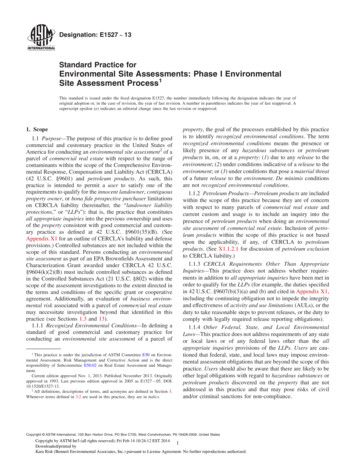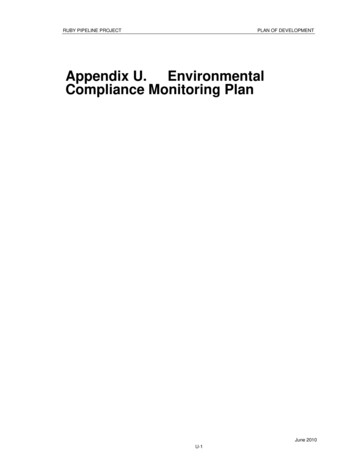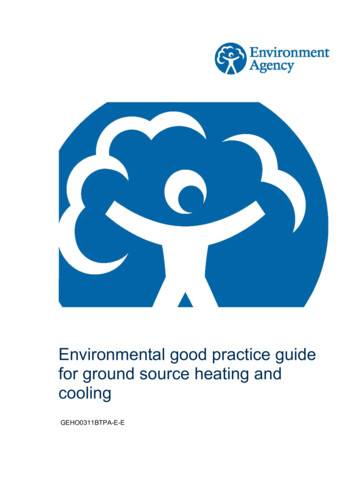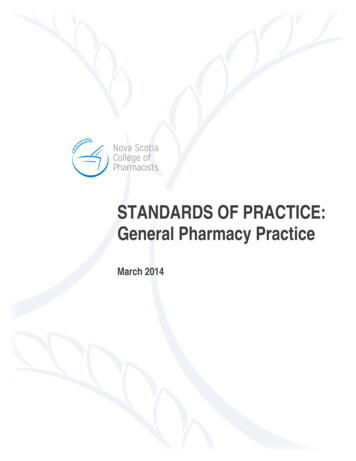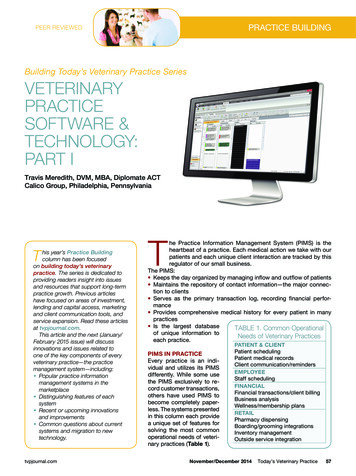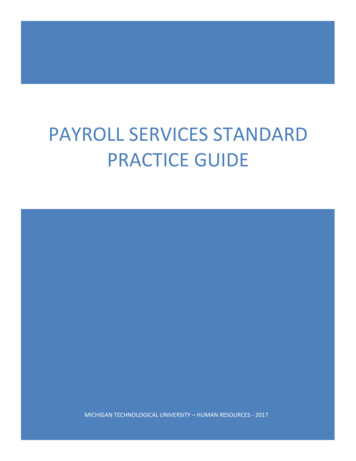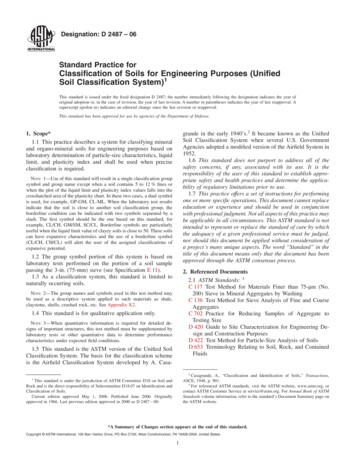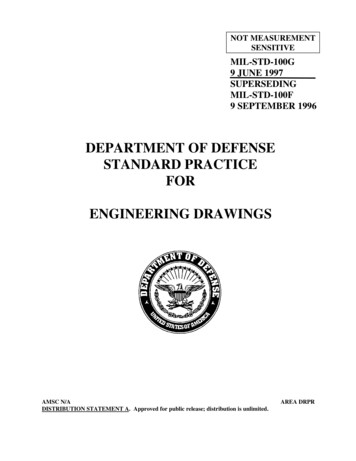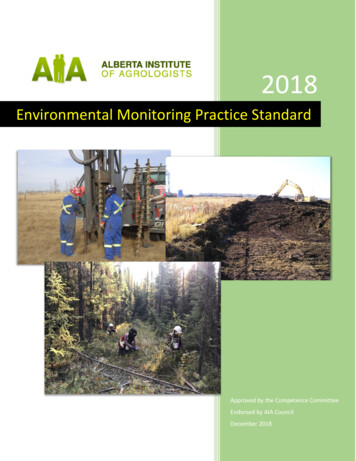
Transcription
2018Environmental Monitoring Practice StandardApproved by the Competence CommitteeEndorsed by AIA CouncilDecember 2018
PrefaceThis practice standard is part of the continuing effort by the Alberta Institute of Agrologists (AIA)to meet its mandate as outlined in the Agrology Profession Act. The Act specifies that the Institutemust establish, maintain and enforce standards of practice as part of the profession’s obligationto protect the public in matters related to agrology.This document was created by a Practice Area Expert Committee (PAEC) consisting of fiveregulated members of the AIA. Members were selected for their expertise and long-standingpractice in environmental monitoring.This practice standard is the basis upon which practice reviews will be conducted by the AIA.This document will assist members in ensuring that their professional practice meets thestandards for education, work experience, skills and performance required for professionalspracticing in environmental monitoring.This document will be reviewed periodically to ensure it is up-to-date with current standards andstate of knowledge for the practice area.1
AcknowledgmentsThe Alberta Institute of Agrologists acknowledges the following people for their contribution tothis practice standard as members of the PAEC for the Environmental Monitoring practice area:Claudia Gomez (P.Ag.)Matrix Solutions Inc.Emmanuel Mapfumo (P.Ag.)NAITJim Purves (P.Ag.)North Shore Environmental Consultants Inc.Kevin Romeo (P.Ag.)Independent ConsultantEd Toews (P.Ag.)Toews Land Services Ltd.The PAEC was chaired by Les Fuller P.Ag (AIA).The AIA would like to thank the following for their review of and feedback on this practicestandard:Michelle Cotton (P.Ag.)Solstice CanadaLenz Haderlein (P.Ag.)Golder Associates Ltd.Danny Lajoie (P.Ag.)North Shore Environmental Consultants Inc.Len Leskiw (P.Ag.)Paragon Soil and Environmental Consulting (retired)Tyler Martin (P.Ag.)North Shore Environmental Consultants Inc.Ryan Muri (P.Ag.)Trace Associates Inc.Darrell Peters (P.Ag.)Independent ConsultantAlan Kennedy (P.Ag.)University of CalgaryThe AIA thanks those members who reviewed the document and provided valuable feedback tothe PAEC.Photo Credits: D. Dabrow, E. Toews2
Table of ContentsPreface . 1Acknowledgments . 2List of Tables . 41. INTRODUCTION. 51.1. Objectives. 51.2. Definitions. 52. SCOPE OF THE PRACTICE AREA . 62.1 Baseline Establishment . 72.2 Construction Monitoring . 72.3 Operations Monitoring . 82.4 Post-operations Monitoring . 92.5 Regulatory Review and Enforcement. 92.6 Other Monitoring . 93. KNOWLEDGE REQUIREMENTS .103.1 Core Knowledge Areas .103.1.1 Air .103.1.2 Contaminants .103.1.3 Data .103.1.4 Ecology .103.1.5 Soils .103.1.6 Vegetation .113.1.7 Water .114. WORK EXPERIENCE .124.1 Years of Experience .134.2 Skill Sets.155. PERFORMANCE REQUIREMENTS .166. REFERENCE MATERIAL .177. SUMMARY.19Appendix A .20Appendix B .233
List of TablesTable 1. Knowledge Requirements for the Environmental Monitoring Practice Area .12Table 2. Work Experience .13Table 3. Required Skill Sets for the Environmental Monitoring Practice Area .154
1. INTRODUCTIONThis practice standard applies to regulated members of the Alberta Institute of Agrologists (AIA)who practice or intend to practice in the Environmental Monitoring practice area. It definesexpectations and outlines requirements regarding professional practice within this area ofpractice. Documentation of these requirements provides necessary assurance to the public thatthe Agrology profession has identified requirements for professional practice. This practicestandard provides members with a benchmark from which to assess their practice and identifypotential learning needs in their continuing competence program. In addition, this standardprovides information to employers to assist them in selecting employees qualified to work withinthe Environmental Monitoring practice area.This practice standard forms the basis for implementation of a practice review protocol for thispractice area. Members working within this practice area will be able to request a review of theirprofessional practice based on this practice standard. Such a review will provide valuable inputfor areas of improvement.1.1. ObjectivesThe objectives of this practice standard include the following: To clearly define the scope of the Environmental Monitoring practice area; To identify and to define the education, experience, skills and performance requirements forprofessional practice within the practice area. To provide documentation of these requirements so regulated members of AIA may assesstheir practice against this standard and identify learning needs to ensure they meet thestandard. To provide a standard against which member’s professional practices may be reviewed bya peer review committee to assist members in identifying areas where they needprofessional development, and To provide a mechanism whereby AIA can demonstrate that the profession is managed ina manner that protects the interests of the public in matters related to environmentalmonitoring work conducted by regulated members of the AIA.1.2. DefinitionsAgrologist: A registered member of the Agrology profession who is regulated by the AlbertaInstitute of Agrologists and who is actively practicing Agrology as defined in the AgrologyProfession Act.Competence: The ability to perform certain tasks in a professional practice based on educationaltraining, skills and work experience in a manner that meets performance objectives as defined ina practice standard.Core Knowledge Area: A general area of knowledge consisting of one or more specializedsubject matter areas that are required for practice within a practice area (e.g. soils, vegetationand water).Direct Supervision: Guidance and direction provided by a competent professional who acceptsresponsibility for work conducted by a less experienced professional.Environmental Monitoring: The activities involved in developing a scientifically defensiblesampling program and the collection of credible data for the purposes of meeting approvalconditions and/or informing decision-making regarding environmental quality.5
Experience: Knowledge or practical wisdom gained from observation or doing.Performance: The exercise of knowledge in a professional practice that demonstrates therequired ethical conduct and wise judgment as specified within a practice standard.Practice Area: A unique functional area of professional practice within the agrology professionthat requires specialized knowledge, based on education, work experience and skill sets.Practice Area Expert Committee: A committee of experts who have demonstrated through theirprofessional practice that they have a comprehensive understanding of the requirements forprofessional practice in a practice area.Practice Review: A process whereby a peer review panel examines a regulated member’sprofessional practice against a practice standard, to provide input on practice improvement.Practice Standard: A document that outlines requirements and expectations for professionalpractice within a practice area.Professional Practice: The competent and ethical provision of specialized knowledge,recommendations and assessments based on education, work experience and skill sets whilebeing accountable to peers as a regulated member of a professional regulatory organization.Regulated Member: A member in good standing with the Alberta Institute of Agrologists whoholds one of the following designations: PAg (Professional Agrologist) RT(Ag) (RegisteredTechnologist in Agrology), AIT (Agrologist in Training) or ATT (Agrology Technologist in Training).Skill: An ability developed over multiple years of work experience in a professional practice.Subject Matter Area: A specialized area of knowledge required for professional practice within apractice area (e.g. soil chemistry, plant physiology, hydrology).2. SCOPE OF THE PRACTICE AREAThe Environmental Monitoring practice area of the Agrology profession focuses on evaluatingenvironmental media and conditions while working toward compliance of human activities withenvironmental standards and guidelines.Professional Agrologists and Registered Technologists in Agrology bring their knowledge ofenvironmental media (soils, vegetation, water, and air) and the interaction of these to the practiceof environmental monitoring. The work conducted by Agrologists involves managing andmonitoring the effect of industrial activities to minimize environmental impacts. This includes thedevelopment and implementation of scientifically defensible processes and protocols forevaluating environmental media to establish conditions prior to, during and after development.Agrologists provide interpretation of data from, and direction to, projects to derive mitigationstrategies and suggest appropriate courses of action for various types of development. The workinvolves safely collecting and handling representative samples; preparation of environmental data(e.g. soils, vegetation, water, air); data analysis and interpretation; accurate field reporting andfield supervision, final report preparation, and defence of data in regulatory regimes or publicforums.The work involved in the Environmental Monitoring practice area consists primarily of the followingcore activities: Baseline EstablishmentConstruction Monitoring6
Operations MonitoringPost-operations MonitoringRegulatory Review and Enforcement, andOther MonitoringThe work involved in these activities is often closely linked to but not limited to environmentallegislation and operational approvals for several types of commercial and industrialdevelopments. Agrologists who work within this practice area play a vital role in fulfilling theenvironmental monitoring requirements of development approvals as well as ensuringenvironmental protection plans are being followed. Agrologists may work for consultingcompanies, industry firms, government regulatory agencies (provincial, federal, municipal), nongovernmental agencies, public organizations, private citizens (e.g. farmers or ranchers) oreducational and research institutions.2.1 Baseline EstablishmentBaseline establishment involves developing a scientifically defensible sampling plan, collectingrepresentative samples and/or field data, analyzing and interpreting data to accurately documentthe state of environmental media in an area prior to initiation of a human activity. This includessuch activities as pre-disturbance assessments, soil mapping and soil salvage planning,vegetation identification and mapping, wetland delineation, hydrology monitoring (streams, rivers,lakes, groundwater), evaluation of slope stability and erosion potential, watercourse crossingmonitoring, working with appropriate specialists to identify and account for environmentallysensitive areas such as wildlife habitat. The data collected are used for determining if any changeoccurs in the condition of environmental media and conditions during construction and operationsof various developments. Data collected include both short-term baseline establishment thatoccurs immediately prior to initiation of a development and long-term baseline establishment todetermine variability of conditions prior to future development activity.The data provide for future analyses to evaluate change in environmental quality over time. Forexample, baseline soils data are used to determine the site-specific chemical and physicalcharacteristics of the development area (including any potentially imported fill/pad material), andit is important to understand the baseline data in terms of any pre-existing naturally elevatedparameters such as salts, metals and hydrocarbons. Baseline soil data are also used to determinethe soil salvage and stripping plan, calculating soil volumes, and determining stockpile area.Baseline vegetation data are used to develop a reclamation plan, support weed managementduring construction and operations, and for rare plant mitigation and avoidance duringconstruction. The environmental monitor works closely with various environmental specialists onan as-needed basis depending on the site-specific conditions and project objectives.2.2 Construction MonitoringConstruction activities have the potential to directly affect the quality of environmental media (e.g.soil, water, vegetation, air.). The main function of environmental monitors is to support theconstruction/development activities. Their overall responsibility is to ensure that applicabledevelopment approval conditions and legislative requirements are being met while the activity isunderway. This is accomplished by documentation and inspections, data collection, regularmeetings and training with construction personnel, and regular project reporting.Regulatory approvals generally contain clauses requiring the presence of a qualifiedenvironmental monitor on site to monitor the effectiveness of construction methods and advise ofchanges needed to effectively protect the environment. For example, soil salvage, handling and7
storage are requirements of many development approvals where soil disturbance occurs.Regulatory documents such as the Master Schedule of Standards and Conditions1 (whichincludes best management practices) provide direction to support construction monitoringprograms and regulatory compliance. The environmental monitor is responsible to ensure thatsoil degradation is minimized due to soil salvage in wet or dry conditions so that closure land usegoals and targets will be achieved. In some cases, the environmental monitor oversees both thesalvage and the replacement of soil for reclamation purposes (e.g. pipeline construction). Otheractivities may include weed and/or stockpile management, monitoring of vegetation (includingrare plants) salvage and re-planting as well as sampling of nearby water bodies and water coursesand general water management on and off site (e.g. dewatering of trenches) during theconstruction phase of a development. The environmental monitor must ensure that appropriateenvironmental specialists are available on an as-needed basis depending on site-specificconditions. In addition, the environmental monitor is responsible to prepare, collect, organize andensure correct dissemination of environment-related information and documentation as well asaddress any accidental releases of contaminants that arises during construction.2.3 Operations MonitoringOngoing monitoring over the long-term on a periodic basis occurs following end of constructionthrough the operational life of a facility. This monitoring is generally conducted to ensurecompliance with Environmental Protection and Enhancement Act (EPEA) site-specific approvalrequirements. For example, regulatory documents such as the Soil Monitoring Directive2 and theCanadian Council of Ministers of the Environment (CCME) Guidance Manual for SiteCharacterization3 provide direction to development of environmental monitoring programs forregulatory compliance.Operations Monitoring includes a wide variety of activities across Alberta that engages manypractitioners. To manage and monitor an Approval site, the practitioner needs to be versed inregulatory documents, requirements, and updates. In addition, the practitioner must be able toidentify specialists to develop Ground Water Monitoring systems (as per approval requirements)as well as to develop Ground Water monitoring programs. Managing waste on-site to meetapproval conditions is a necessity. Storm water collection, management, testing, and reportingcan be daily tasks that have to be directed by an Operations Monitoring professional.Air monitoring is becoming an increasingly large part of Operations Monitoring. SGRR, MSAPR,SGER, NPRI, Fugitive Emissions, Methane emissions, etc. are directives and regulations thatmust be monitored and managed on an operating facility.All these parameters are part of facilities work. An operations monitoring professional deals withsite specific liability assessment, asset retirement obligations, historic impacts, contaminated site,ground water impacts, erosion control, storm water management, vegetation management,brushing, right-of-way subsidence, meeting post construction monitoring report requirements, site1Government of Alberta, 2017. Master Schedule of Standards and Conditions. Alberta Environment andParks, Edmonton, AB.2 Government of Alberta, 2009. Soil Monitoring Directive. Climate Change, Air and Land Policy Branch,Environmental Assurance Division, Alberta En
practice in environmental monitoring. This practice standard is the basis upon which practice reviews will be conducted by the AIA. This document will assist members in ensuring that their professional practice meets the standards for education, work experience, skills and performance required for professionals
